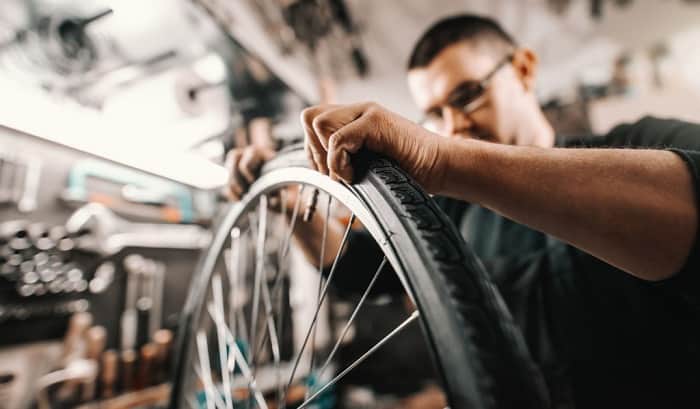Bicycle tires are subject to wear and tear. It can affect how your bike wheels perform and its puncture resistance. Worn-out tires can lead you to dangerous situations that result in serious injury.
Tires should eventually be replaced for better performance, grip, and protection. Hence, you should know when to replace bike tires, so your bike can function effectively, especially when you are on a challenging road or terrain.
There are a number of ways to tell when your bicycle tires need replacement. It can be due to the tire aging or the tire wearing out. To know more, you can read this guide to help you identify the warning signs of a bike tire requiring replacement.
Table of Contents
Why Should You Replace Bike Tires
Your front and rear tires are important components of your bicycle. The bike tire is the main contact point of the bicycle with the road, and can heavily be exposed to puncture and damage. It is crucial that your bike tires deliver excellent performance to ensure success on the road.
You should replace badly-performing bike tires to yield better results when biking. A fully functioning bike tire provides you the following:
1. Safety
Safety should be the number one reason you replace mountain bike tires. When you have old tires or worn-out tires, your safety will be compromised. Tires come with a rubber material that can wear out and reduce the road grip. A compromised road grip can cause accidents when biking.
2. Control
Worn or old tires lose their shape eventually and can create an uneven wheel alignment. It will no longer look round in the cross-section because of the tread wearing out. This causes balance problems, which may lead you to lose control of the bicycle.
The traction of your front tires is responsible for steering and braking. With a poorly functioning front tire, you will have difficulty in stopping or braking effectively. It can lead to crashing, which can injure you and damage the bike.
3. Peace of mind
Having fully functioning bicycle tires gives you peace of mind when you are on the road. You are more confident in navigating challenging trails because of better road grip and control. You also know that your tire has enough puncture protection and can resist any tire pressure even on rough surfaces.
4. Time to Replace Your Tires
There are two major reasons why you should replace your road bike tires with new bike tires – tire wear and tire age.
Even the most durable and high-quality tires are subject to wear and tear. You can easily spot a worn tire when you experience issues with wheel alignment and balance. You should also take note of the tire tread that must be evenly placed across the whole tire instead of the interior or the exterior of the tire. If this happens, your tires will significantly experience wear and tear.
Another reason is when either your rear tire or front tire ages due to environmental conditions or exposure to chemicals and substances. When one of the components of the tire such as rubber and inner tube begins to exhibit significant change, it indicates that the tire is aging significantly. With old road bike tires, you might not get the optimum performance with your bicycle.
Aside from wearing and aging, there are other warning signs indicating that your bike tire needs replacement.
5. Worn or bald tread
The tread patterns are a great way to know when the bike tire needs a replacement. If you are constantly using your bike, the tire will be heavily exposed to rough surfaces, which trigger the balding of your tire tread. The bicycle tread pattern has a very important purpose. It provides a better bite on loose surfaces like mud, sand, and rocks.
With bald bike tires, you can lose grip when biking. It is essential to look for tread wear indicators, so you know when to change bike tires. Most of the time, the color of the tire fades due to worn tread. It looks dry and dull upon inspection.
6. Worn or cracked sidewalls
Normally, your bike sidewalls will wear out first before your tire tread. The cracks on your tire sidewalls or dry rot tires are caused by insufficient inflation pressure that damages the tire. It will result in premature failure.
You will notice worn-out sidewalls if there is uneven tread wear and a bald area on the right or left side of the bike tire. Rubber chipping, dull, dry, and brittle tires also indicate damaged sidewalls or cracked bike tires. So, it is crucial to check and adjust the pressure using a pressure gauge before each bike ride. Proper storage of your bike can also prolong the tire lifespan.
7. Defects
In some cases, even a new tire of mountain bikes can be subject to replacement. There are incidents where you might get a tire with defects or inconsistencies straight from the manufacturer. It is the result of poor packaging where manufacturers fold bike tires for shipping.
Poor storage can also damage the tires, especially when stored on hot pavements that can potentially soften the rubber component. It is important to always check for defects when buying a new bicycle tire. If possible, we recommend going to a bike shop to physically check the product before buying.
8. Repeated or frequent flats
If there is no visible damage to the physical condition of the bike tire, but you experience flat tires repeatedly, it is an indication that the tire needs to be replaced. If the tire consistently exhibits flats from small stones and broken glass, your tire will be extremely vulnerable to any sharp object that can lead to complete damage or tire catastrophic failure.
9. Tire squaring off
Your tire squaring off is also an indication that the tire needs a replacement. Rear tires are subject to squaring because they carry the pressure and extra weight of the rider. Squared-off tires will not run smoothly or speed up when necessary.
10. Exposed casing
You will notice that your bike tire is deliberately worn out when you can already see its casing popping out. The casing is usually the third layer of the tire that typically happens in both the front wheel and back tire.
If you use a road bike tire with an exposed casing, you are prone to accidents and danger. The only thing that keeps the tire together is a thin section of casing not designed to be in contact with road surfaces. You might need to replace bicycle tires to prevent getting into an accident.
11. Bulges and bubbles
You will notice this kind of issue when you ride on the tire. Road tires with bulges and bubbles will not run smoothly. You can feel consistent bumps when riding. This happens on road tires sidewall, which can potentially burst any time.
Perished bike tyres cause the bike to crash, leading to serious road accidents. If you notice some bulges and bubbles, you should fix the tire immediately using the tire boot. You can still repair the tire, especially when the damage is small.
Conclusion
Success on the road highly depends on how your bicycle tire performs. Since they are s one of the most important components of your bike, it is crucial to inspect them regularly and look for any bicycle tire wear indicator. Tires wear because of various reasons. When they are exposed or experience poor handling, your tires will not perform effectively and can affect your riding style.
May this guide on when to replace bike tires help you identify the various reasons why you should replace bicycle tires. We kept it straightforward and comprehensive so you know how often to change bike tires next time.

“I ride my bike to work for years, but is that enough? Our carelessness towards our surroundings has taken a toll on the environment. And now, everyone is responsible for changes; even the most minor contribution is counted. With this hope and spirit, I started with my partner to establish Biketoworkday to help more individuals commute to their work sites on their bikes.”





